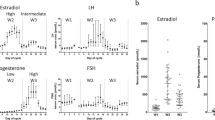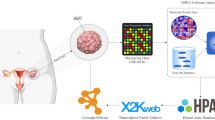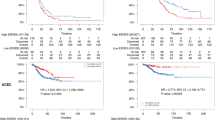Abstract
Estrogens regulate normal ovarian surface epithelium (OSE) cell functions but also affect epithelial ovarian cancer (OCa) development. Little is known about how estrogens play such opposing roles. Transcriptional profiling using a cDNA microarray containing 2400 named genes identified 155 genes whose expression was altered by estradiol-17β (E2) in three immortalized normal human ovarian surface epithelial (HOSE) cell lines and 315 genes whose expression was affected by the hormone in three established OCa (OVCA) cell lines. All but 19 of the genes in these two sets were different. Among the 19 overlapping genes, five were found to show discordant responses between HOSE and OVCA cell lines. The five genes are those that encode clone 5.1 RNA-binding protein (RNPS1), erythrocyte adducin α subunit (ADD1), plexin A3 (PLXNA3 or the SEX gene), nuclear protein SkiP (SKIIP), and Rap-2 (rap-2). RNPS1, ADD1, rap-2, and SKIIP were upregulated by E2 in HOSE cells but downregulated by estrogen in OVCA cells, whereas PLXNA3 showed the reverse pattern of regulation. The estrogen effects was observed within 6–18 h of treatment. In silicon analyses revealed presence of estrogen response elements in the proximal promoters of all five genes. RNPS1, ADD1, and PLXNA3 were underexpressed in OVCA cell lines compared to HOSE cell lines, while the opposite was true for rap-2 and SKIIP. Functional studies showed that RNPS1 and ADD1 exerted multiple antitumor actions in OVCA cells, while PLXNA3 only inhibited cell invasiveness. In contrast, rap-2 was found to cause significant oncogenic effects in OVCA cells, while SKIIP promotes only anchorage-independent growth. In sum, gene profiling data reveal that (1) E2 exerts different actions on HOSE cells than on OVCA cells by affecting two distinct transcriptomes with few overlapping genes and (2) among the overlapping genes, a set of putative oncogenes/tumor suppressors have been identified due to their differential responses to E2 between the two cell types. These findings may explain the paradoxical roles of estrogens in regulating normal and malignant OSE cell functions.
This is a preview of subscription content, access via your institution
Access options
Subscribe to this journal
Receive 50 print issues and online access
$259.00 per year
only $5.18 per issue
Buy this article
- Purchase on Springer Link
- Instant access to full article PDF
Prices may be subject to local taxes which are calculated during checkout









Similar content being viewed by others
Accession codes
Accessions
GenBank/EMBL/DDBJ
References
AACR (2005). Statistics.
Anderson GL, Judd HL, Kaunitz AM, Barad DH, Beresford SA, Pettinger M, Liu J, McNeeley SG and Lopez AM. (2003). JAMA, 290, 1739–1748.
Badolato J, Gardiner E, Morrison N and Eisman J . (1995). Gene, 166, 323–327.
Bai W, Oliveros-Saunders B, Wang Q, Acevedo-Duncan ME and Nicosia SV . (2000). In vitro Cell Dev. Biol. Anim., 36, 657–666.
Bakken K, Alsaker E, Eggen AE and Lund E . (2004). Int. J. Cancer, 112, 130–134.
Bardin A, Hoffmann P, Boulle N, Katsaros D, Vignon F, Pujol P and Lazennec G . (2004). Cancer Res., 64, 5861–5869.
Bast Jr RC, Feeney M, Lazarus H, Nadler LM, Colvin RB and Knapp RC . (1981). J. Clin. Invest, 68, 1331–1337.
Baudino TA, Kraichely DM, Jefcoat Jr SC, Winchester SK, Partridge NC and MacDonald PN . (1998). J. Biol. Chem., 273, 16434–16441.
Bennett V and Baines AJ . (2001). Physiol. Rev., 81, 1353–1392.
Birkenmeier CS and Barker JE . (2004). J. Pathol., 204, 450–459.
Bowen SL, Bloor BK, Leigh IM and Waseem A . (2003). J. Pathol., 201, 119–126.
Callow ME, Callow JA, Ista LK, Coleman SE, Nolasco AC and Lopez GP . (2000). Appl. Environ. Microbiol., 66, 3249–3254.
Campbell SL, Khosravi-Far R, Rossman KL, Clark GJ and Der CJ . (1998). Oncogene, 17, 1395–1413.
Caron E, Self AJ and Hall A . (2000). Curr. Biol., 10, 974–978.
Chadwick CC, Chippari S, Matelan E, Borges-Marcucci L, Eckert AM, Keith Jr JC, Albert LM, Leathurby Y, Harris HA, Bhat RA, Ashwell M, Trybulski E, Winneker RC, Adelman SJ, Steffan RJ and Harnish DC . (2005). Proc. Natl. Acad. Sci. USA, 102, 2543–2548.
Cheng HJ, Bagri A, Yaron A, Stein E, Pleasure SJ and Tessier-Lavigne M . (2001). Neuron, 32, 249–263.
Dahl R, Wani B and Hayman MJ . (1998). Oncogene, 16, 1579–1586.
Dennis Jr G, Sherman BT, Hosack DA, Yang J, Gao W, Lane HC and Lempicki RA . (2003). Genome Biol., 4, 3.
DeNardo DG, Kim HT, Hilsenbeck S, Cuba V, Tsimelzon A and Brown PH . (2005). Mol. Endocrinol., 19, 362–378.
Faustino NA and Cooper TA . (2003). Genes Dev., 17, 419–437.
Folk P, Puta F, Krpejsova L, Blahuskova A, Markos A, Rabino M and Dottin RP . (1996). Gene, 181, 229–231.
Fowler L, Everitt J, Stevens JL and Jaken S . (1998). Cell Growth Differ., 9, 405–413.
Galtier-Dereure F, Capony F, Maudelonde T and Rochefort H . (1992). J. Clin. Endocrinol. Metab., 75, 1497–1502.
Garg PP, Kerlikowske K, Subak L and Grady D . (1998). Obstet. Gynecol., 92, 472–479.
Ghisletti S, Meda C, Maggi A and Vegeto E . (2005). Mol. Cell. Biol., 25, 2957–2968.
Gorringe KL, Chin SF, Pharoah P, Staines JM, Oliveira C, Edwards PA and Caldas C . (2005). Carcinogenesis, 26, 923–930.
Hall JM and Korach KS . (2003). Mol. Endocrinol., 17, 792–803.
Heinonen PK, Tuimala R, Pyykko K and Pystynen P . (1982). Br. J. Obstet. Gynaecol., 89, 84–86.
Ho SM . (2003). Reprod. Biol. Endocrinol., 1, 73–80.
Ho SM, Lau KM, Mok SC and Syed V . (2003). Oncogene, 22, 4243–4256.
Hough CD, Cho KR, Zonderman AB, Schwartz DR and Morin PJ . (2001). Cancer Res., 61, 3869–3876.
Janoueix-Lerosey I, Polakis P, Tavitian A and de Gunzburg J . (1992). Biochem. Biophys. Res. Commun., 189, 455–464.
Jimenez B, Pizon V, Lerosey I, Beranger F, Tavitian A and de Gunzburg J . (1991). Int. J. Cancer, 49, 471–479.
Katabuchi H and Okamura H . (2003). Med. Electron Microsc., 36, 74–86.
Katagiri K, Hattori M, Minato N, Irie S, Takatsu K and Kinashi T . (2000). Mol. Cell. Biol., 20, 1956–1969.
Kim K, Barhoumi R, Burghardt R and Safe S . (2005). Mol. Endocrinol., 9, 843–854.
Kim VN, Kataoka N and Dreyfuss G . (2001). Science, 293, 1832–1836.
Lancaster JM, Dressman HK, Whitaker RS, Havrilesky L, Gray J, Marks JR, Nevins JR and Berchuck A . (2004). J. Soc. Gynecol. Invest., 11, 51–59.
Langdon SP, Crew AJ, Ritchie AA, Muir M, Wakeling A, Smyth JF and Miller WR . (1994). Eur. J. Cancer, 30A, 682–686.
Langdon SP, Hawkes MM, Lawrie SS, Hawkins RA, Tesdale AL, Crew AJ, Miller WR and Smyth JF . (1990). Br. J. Cancer, 62, 213–216.
Langdon SP, Ritchie A, Young K, Crew AJ, Sweeting V, Bramley T, Hillier S, Hawkins RA, Tesdale AL and Smyth JF . (1993). Int. J. Cancer, 55, 459–464.
Lassus H, Leminen A, Lundin J, Lehtovirta P and Butzow R . (2003). Gynecol. Oncol., 91, 504–512.
Lau KM, Mok SC and Ho SM . (1999). Proc. Natl. Acad. Sci. USA, 96, 5722–5727.
Lau KM, Tam NN, Thompson C, Cheng RY, Leung YK and Ho SM . (2003). Lab. Invest., 83, 743–757.
Lee BC, Cha K, Avraham S and Avraham HK . (2004). Int. J. Oncol., 24, 847–851.
Leong GM, Subramaniam N, Figueroa J, Flanagan JL, Hayman MJ, Eisman JA and Kouzmenko AP . (2001). J. Biol. Chem., 276, 18243–18248.
Leong GM, Subramaniam N, Issa LL, Barry JB, Kino T, Driggers PH, Hayman MJ, Eisman JA and Gardiner EM . (2004). Biochem. Biophys. Res. Commun., 315, 1070–1076.
Lerosey I, Chardin P, de Gunzburg J and Tavitian A . (1991). J. Biol. Chem., 266, 4315–4321.
Lykke-Andersen J, Shu MD and Steitz JA . (2001). Science, 293, 1836–1839.
Maestrini E, Tamagnone L, Longati P, Cremona O, Gulisano M, Bione S, Tamanini F, Neel BG, Toniolo D and Comoglio PM . (1996). Proc. Natl. Acad. Sci. USA, 93, 674–678.
Mariani L, Beaudry C, McDonough WS, Hoelzinger DB, Demuth T, Ross KR, Berens T, Coons SW, Watts G, Trent JM, Wei JS, Giese A and Berens ME . (2001). J. Neurooncol., 53, 161–176.
Matsuoka Y, Li X and Bennett V . (2000). Cell Mol. Life Sci., 57, 884–895.
Mayeda A, Badolato J, Kobayashi R, Zhang MQ, Gardiner EM and Krainer AR . (1999). EMBO J., 18, 4560–4570.
McLeod SJ, Shum AJ, Lee RL, Takei F and Gold MR . (2004). J. Biol. Chem., 279, 12009–12019.
Nagata K, Itoh H, Katada T, Takenaka K, Ui M, Kaziro Y and Nozawa Y . (1989). J. Biol. Chem., 264, 17000–17005.
Nash JD, Ozols RF, Smyth JF and Hamilton TC . (1989). Obstet. Gynecol., 73, 1009–1016.
Neufeld G, Shraga-Heled N, Lange T, Guttmann-Raviv N, Herzog Y and Kessler O . (2005). Front. Biosci., 10, 751–760.
Okamura H, Katabuchi H and Ohba T . (2003). Mol. Cell. Endocrinol., 202, 37–45.
Pavao M, Huang YH, Hafer LJ, Moreland RB and Traish AM . (2001). BMC Cancer, 1, 15.
Prathapam T, Kuhne C and Banks L . (2002). Nucleic Acids Res., 30, 5261–5268.
Quandt K, Frech K, Karas H, Wingender E and Werner T . (1995). Nucleic Acids Res., 23, 4878–4884.
Reedquist KA, Ross E, Koop EA, Wolthuis RM, Zwartkruis FJ, van Kooyk Y, Salmon M, Buckley CD and Bos JL . (2000). J. Cell Biol., 148, 1151–1158.
Riman T, Dickman PW, Nilsson S, Correia N, Nordlinder H, Magnusson CM, Weiderpass E and Persson IR . (2002). J. Natl. Cancer Inst., 94, 497–504.
Riman T, Nilsson S and Persson IR . (2004). Acta Obstet. Gynecol. Scand., 83, 783–795.
Roche J and Drabkin HA . (2001). Clin. Lung Cancer, 3, 145–150.
Runge HM, Neumann HA, Bauknecht T and Pfleiderer A . (1986a). Eur. J. Cancer Clin. Oncol., 22, 691–696.
Runge HM, Teufel G, Neulen J, Geyer H and Pfleiderer A . (1986b). Cancer Chemother. Pharmacol., 16, 58–63.
Sakamoto M, Kondo A, Kawasaki K, Goto T, Sakamoto H, Miyake K, Koyamatsu Y, Akiya T, Iwabuchi H, Muroya T, Ochiai K, Tanaka T, Kikuchi Y and Tenjin Y . (2001). Hum. Cell, 14, 305–315.
Santin AD, Zhan F, Bellone S, Palmieri M, Cane S, Gokden M, Roman JJ, O’Brien TJ, Tian E, Cannon MJ, Shaughnessy Jr J and Pecorelli S . (2004). Br. J. Cancer, 90, 1814–1824.
Simpson BJ, Langdon SP, Rabiasz GJ, Macleod KG, Hirst GL, Bartlett JM, Crew AJ, Hawkins RA, Macineira-Perez PP, Smyth JF and Miller WR . (1998). J. Steroid Biochem. Mol. Biol., 64, 137–145.
Sit AS, Modugno F, Weissfeld JL, Berga SL and Ness RB . (2002). Gynecol. Oncol., 86, 118–123.
Song J, Fadiel A, Edusa V, Chen Z, So J, Sakamoto H, Fishman DA and Naftolin F . (2005). Cancer Lett., 220, 57–65.
Stopper H, Schmitt E, Gregor C, Mueller SO and Fischer WH . (2003). Mutagenesis, 18, 243–247.
Sugimura M, Sagae S, Ishioka S, Nishioka Y, Tsukada K and Kudo R . (2004). Oncology, 66, 53–61.
Syed V and Ho SM . (2003). Oncogene, 22, 6883–6890.
Syed V, Mukherjee K, Lyons-Weiler J, Lau KM, Mashima T, Tsuruo T and Ho SM . (2005). Oncogene, 24, 1774–1787.
Syed V, Ulinski G, Mok SC and Ho SM . (2002). J. Natl. Cancer Inst., 94, 617–629.
Syed V, Ulinski G, Mok SC, Yiu GK and Ho SM . (2001). Cancer Res., 61, 6768–6776.
Tamagnone L and Comoglio PM . (2000). Trends Cell Biol., 10, 377–383.
Taube M, Hockenstrom T, Isaksson M, Lindgren PR and Backstrom T . (2002). Int. J. Oncol., 20, 589–594.
Tsao SW, Mok SC, Fey EG, Fletcher JA, Wan TS, Chew EC, Muto MG, Knapp RC and Berkowitz RS . (1995). Exp. Cell Res., 218, 499–507.
Tse C, Xiang RH, Bracht T and Naylor SL . (2002). Cancer Res., 62, 542–546.
Tsukamoto N, Hattori M, Yang H, Bos JL and Minato N . (1999). J. Biol. Chem., 274, 18463–18469.
Welsh JB, Zarrinkar PP, Sapinoso LM, Kern SG, Behling CA, Monk BJ, Lockhart DJ, Burger RA and Hampton GM . (2001). Proc. Natl. Acad. Sci. USA, 98, 1176–1181.
Xiang R, Davalos AR, Hensel CH, Zhou XJ, Tse C and Naylor SL . (2002). Cancer Res., 62, 2637–2643.
Yang YH, Dudoit S, Luu P, Lin DM, Peng V, Ngai J and Speed TP . (2002). Nucleic Acids Res., 30, e15.
Zhang C, Baudino TA, Dowd DR, Tokumaru H, Wang W and MacDonald PN . (2001). J. Biol. Chem., 276, 40614–40620.
Zhou S, Fujimuro M, Hsieh JJ, Chen L, Miyamoto A, Weinmaster G and Hayward SD . (2000). Mol. Cell. Biol., 20, 2400–2410.
Acknowledgements
We thank Dr Kun-Liang Guan at the Department of Biological Chemistry, University of Michigan for providing the Sex gene expression vector and Dr Samuel C Mok at the Laboratory of Gynecologic Oncology, Department of Obstetrics, Gynecology, and Reproductive Biology, Brigham and Women's Hospital, Boston for providing the HOSE and OVCA cell lines. We thank the editorial staff of Brigham and Women's Hospital in Boston for their excellent editorial service. This study was supported, in part, by NIH Grants CA091250 (to VS) and CA94221 (to SMH).
Author information
Authors and Affiliations
Corresponding author
Rights and permissions
About this article
Cite this article
Syed, V., Zhang, X., Lau, KM. et al. Profiling estrogen-regulated gene expression changes in normal and malignant human ovarian surface epithelial cells. Oncogene 24, 8128–8143 (2005). https://doi.org/10.1038/sj.onc.1208959
Received:
Revised:
Accepted:
Published:
Issue Date:
DOI: https://doi.org/10.1038/sj.onc.1208959
Keywords
This article is cited by
-
Progesterone reduces cell survival in primary cultures of endometrioid ovarian cancer
Journal of Ovarian Research (2019)
-
Aberrant miRNAs Regulate the Biological Hallmarks of Glioblastoma
NeuroMolecular Medicine (2018)
-
The semaphorins: versatile regulators of tumour progression and tumour angiogenesis
Nature Reviews Cancer (2008)
-
Dietary fiber intake and ovarian cancer risk: a prospective cohort study
Cancer Causes & Control (2007)



